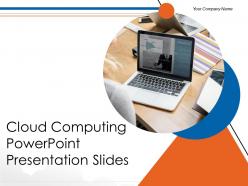Cloud Computing Powerpoint Presentation Slides Complete Deck
Our Cloud Computing Powerpoint Presentation Slides Complete Deck are topically designed to provide an attractive backdrop to any subject. Use them to look like a presentation pro.
You must be logged in to download this presentation.
PowerPoint presentation slides
Presenting our Cloud Computing PowerPoint Presentation Slides Complete Deck. This is a 100% editable and adaptable PPT slide. You can save it in different formats like PDF, JPG, and PNG. It can be edited with different colors, fonts, font sizes, and font types of the template as per your requirements. This template supports the standard (4:3) and widescreen (16:9) format. It is also compatible with Google Slides.
People who downloaded this PowerPoint presentation also viewed the following :
Content of this Powerpoint Presentation
Cloud computing, the technology where you can temporarily shift your work to an available location where resources might be more plentiful, is the world of the future. Statista.com estimates that the cloud computing market will grow 25% 168.6 billion dollars by 2025 from 133.6 billion dollars in 2021. This is clearly the sunrise sector for the next year or so.
Organizations are increasingly using cloud computing to stand out in this competitive business market. Cloud computing has transformed the way technology is used and managed. It promotes efficiency by facilitating seamless data dissemination, processing, and storage across regional borders. With its ability to change the way businesses work and process things, cloud computing drives efficiency and innovation.
The aim is to ensure efficient resource use. Moving to the cloud is a business imperative and not a matter of personal choice. In its importance, cloud computing is akin to the internet today. It simplifies things and frees up the business for a major transformation as well, if it is so inclined.
In this blog, we present our PowerPoint Template Presentation to demonstrate and illustrate the potential of cloud computing!
Let’s explore!
Template 1: What is Cloud?

This PPT Template depicts how data and applications may be accessed, processed, and stored remotely in a cloud, with the internet as the powering source. Users will get a greater understanding of the revolutionary potential of cloud services for both individuals and enterprises by seeing examples of its scalability, flexibility, and cost-effectiveness. The slide helps stakeholders make better use of resources and have a greater appreciation of cloud technology and how it is a game-changer.
Template 2: Business Risk Related to Cloud

There are risks that cloud computing poses. Evaluate the business risks connected to cloud adoption systematically with this slide. On the slide are tell-tell signs on recognizing possible risks. These may be service disruptions, data breaches, and compliance problems. In this way, the severity and probability of the risk coming to pass are covered. The slide also lists a sequence of steps for understanding and tackling recognized risks. The end-goal is to help the user of the slide a smooth experience of integrating the cloud computing technology into their processes and systems.
This slide makes it easier to assess business risks associated with cloud adoption. Users are asked to identify potential risks such as service disruptions, data breaches, and compliance issues. Users can efficiently order mitigation tactics by categorizing risks based on their severity and probability. Users can reduce vulnerabilities, make informed decisions, and ensure the safe and reliable integration of cloud services into their businesses. Get it today!
Template 3: Cloud Computing Use Cases

How to use cloud computing across industries is illustrated well in this slide. This PPT outlines scenarios where cloud deployment, SaaS, SD-WAN, and big data analytics are applicable. This PPT Template offers cloud technology as a problem solver. It resolves and simplifies issues with scalability of business, spread of innovation, and workflow optimization of users' organizations.
Template 4: Cloud Deployment Model

This slide provides a comprehensive analysis and comparison of public, private, community, and hybrid cloud deployment models. It provides consumers with the information they need to make decisions. Understanding how deployment methods differ in execution allows users to develop efficient strategies that balance variables such as security, scalability, cost, and control. Whether it's improving collaboration, streamlining infrastructure, or ensuring regulatory compliance, this slide advises users on which cloud deployment strategy is best for their specific needs. Tap the download button above!
Template 5: Benefits of Hybrid Cloud

This PPT Template showcases the advantages of using a hybrid cloud approach. The aim is to showcase flexibility, which is a combination of cloud services and physical, on-premise work. Workloads can be organized well to ensure there is minimal disruption when cloud is used. Businesses must indulge in Intelligent use of risk management to ensure the cloud is optimally used and serves their needs well. This is the real worth of this document.
Template 6: What is Community Cloud?

This slide serves specialized user groups with shared needs or interests and illustrates the idea and advantages of a community cloud. Industries and businesses across domains of government, healthcare and education find it useful. The cloud's main proposition of safe data transmission is also illustrated and tested through the suggestions on the presentation. By comprehending its typical architecture and customization options, users may use Community Cloud's potential to enhance community efforts, better resource utilization, and create ceaseless innovation in their sectors.
Template 7: Benefit of Community Cloud

This slide outlines the advantages of Community Cloud and highlights its collaborative aspect, encouraging the sharing of knowledge, resources, and creative ideas among certain user groups. By utilizing Community Cloud, users may increase productivity and efficiency by streamlining member cooperation, knowledge sharing, and communication.
Template 8: Cloud Service Models

This slide includes the main models of the cloud. IaaS is used by network and infrastructure architects, PaaS is used by application developers, and SaaS is used by end consumers. Whether using standard software applications, developing and deploying applications, or handling the underlying network infrastructure, with the help of this slide users can choose the appropriate model to optimize resource allocation and improve operations. Get it in a click!
Template 9: Characteristics of Software as a Service (SaaS)

This slide comes up with the essential features of software as a service (SaaS), which includes single sign-on for easy accessibility, multi-tenant models for efficient resource sharing across users, and automated provisioning for hassle-free deployment.
Template 10: Cloud Computing Security

This PPT Template is your passport to a high-level overview of cloud computing security, including components that safeguard infrastructure and data. The encryption techniques are explained as well, giving the user enough confidence that the data is safe, both in terms of confidentiality and integrity. Having a secure data backup makes it possible to rise up faster from accidents or possible breaches. Inspire user confidence in cloud computing, risk reduction and data protection by putting these security measures that are based on cloud computing.
*****
Business Success through Cloud Prowess
The development of contemporary enterprises is dependent on cloud computing, and these templates underscore why cloud computing is so crucial. These slides inspire action and change toward digital excellence by presenting cost-effective deployment strategies, robust security measures, and observable business advantages. Use the cloud computing capability that these slides demonstrate to your advantage and map out a strategy for long-term growth and a competitive edge in the fast-paced corporate world of today.
Cloud Computing Powerpoint Presentation Slides Complete Deck with all 77 slides:
Use our Cloud Computing Powerpoint Presentation Slides Complete Deck to effectively help you save your valuable time. They are readymade to fit into any presentation structure.
FAQs
Cloud computing is a technology that allows users to access and use computing resources over the internet. The types of cloud computing are: public cloud, private cloud, hybrid cloud, and community cloud.
Cloud computing offers numerous benefits, such as: cost savings, scalability, flexibility, disaster recovery, and automatic updates.
Some of the business risks associated with cloud computing are: data security, loss of control over data, vendor lock-in, and compliance issues.
Cloud computing provides on-demand access to resources over the internet, while traditional data centers require physical infrastructure and maintenance.
Businesses should adopt cloud computing for its cost-effectiveness, scalability, and flexibility.
The roadmap to integrate cloud computing in business involves assessing business requirements, selecting the appropriate cloud type and service model, and planning and executing the migration process.
-
Attractive design and informative presentation.
-
Easily Understandable slides.
-
Great product with highly impressive and engaging designs.
-
Attractive design and informative presentation.
-
Great quality slides in rapid time.























































































































































